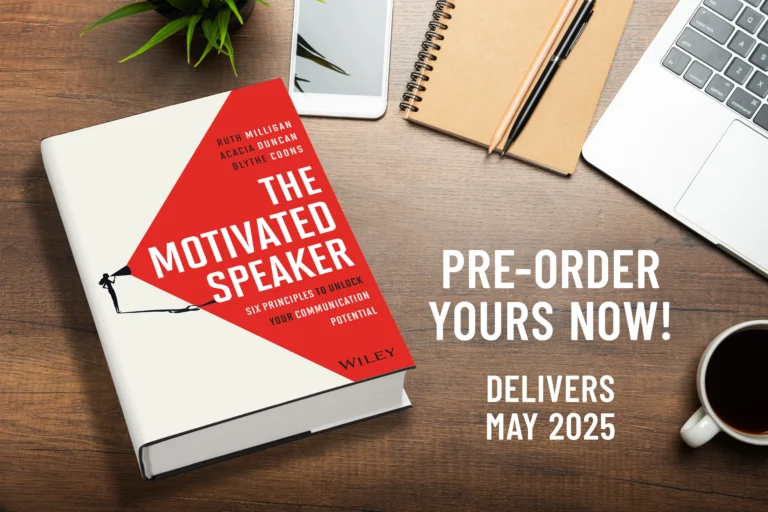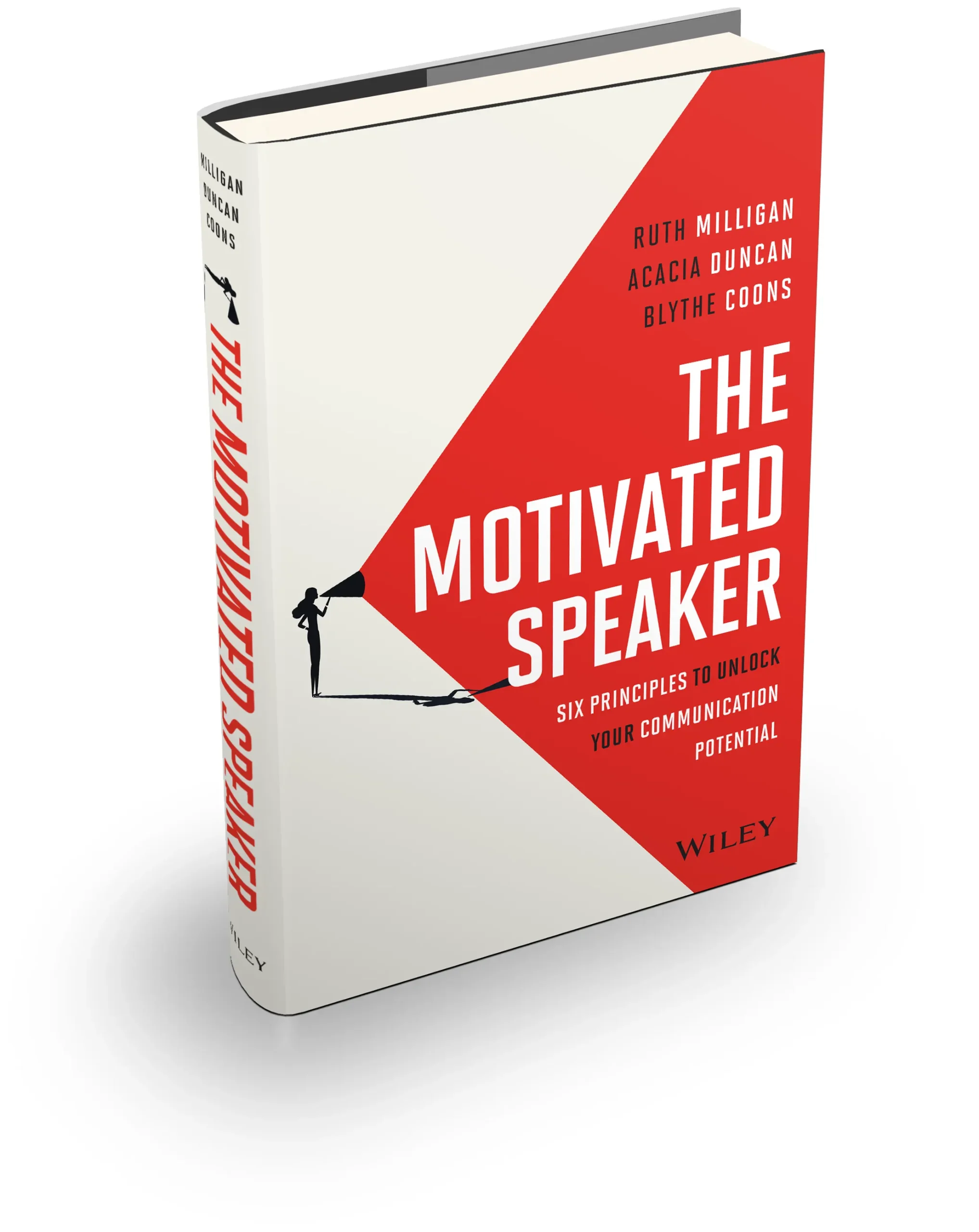The Motivated Speaker comes out May 6, published by Wiley and written by the three of us, Ruth, Acacia and Blythe. We have a full page of info on the book here.
For this blog post we’re going to answer “How did it go – writing the book – together?”
********************** ********************** **********************
On writing The Motivated Speaker
By Ruth, Acacia and Blythe
This is for all of the people who are insatiably curious (nosy?) about other people’s writing process. This was ours.
We are writers
We write every day for our work. Our genres are email, blog posts, social media posts, instructions for training classes, follow up reminders for coaching sessions, proposals and an occasional, hey, please-don’t-forget-to-pay-us reminder.
But, assuredly, our genre is not long-form published work. Especially words that people pay to read.
*******************
If we use one word to describe our writing process that led to The Motivated Speaker, it is simply curiosity. And then after that, a lot of small habits. Here’s how it unfolded phase-by-phase:
Phase 1: After Ruth attended a conference at Miami University (her and Acacia’s alma mater), we learned what a threshold concept was. In very short, it is a troublesome and transformative understanding of something you are learning. We then got we got very curious: who had named them for learning to speak? Our mentor, Elizabeth Wardle, also from Miami, who authored the threshold concepts on learning to write, took us under her wing. We sat with her several times to help us sift through the meanings, sub-concepts and eventual expressions.
Phase 2: After getting a draft list together, we decided to write about them in short form emails, blogs and social posts. We started to pair them with real stories from speakers and find even more sub-concepts. We made this a first quarter 2024 project, each of us taking different concepts alongside a very manageable schedule that spanned 12 weeks. This is probably the most important insight to our process: We meet every Monday from 10am – 12pm. We have a very tight agenda of how to discuss and debate issues relating to the business and our clients. Every single week for the better part of 2024, there were naturally some issue to discuss relating to the concepts. None of them were daunting; each needed a little debate but none were insurmountable. This made the process feel like we were always accomplishing something… and moving the ball down the field, even one yard at a time. And because we have a deep working knowledge of each other and our strengths / shortcomings, our trust level is high, especially when it came to anything “sticky” to decide. Dare we say that was how the three of us navigated a co-authorship so seamlessly.
Phase 3: We shared them in a collection with a few clients and peers through some webinars. We were curious: when presented together, did they resonate with anyone who was also in the space of helping to craft leadership and development programs? (They were).
Phase 4: We decided to write a white paper to get them in one place. Then we realized we had written A LOT more than a white paper. And who reads white papers anymore? In reality, it was about 25,000 words. Not quite a book. But it was enough to spark us again to be curious: what current books exist in the market that may be like it? So – We ordered everything on Amazon that had been published “on the communication shelf” in the last two years. We found 10 self-published books, one-publisher published book (in an adjacent category on voice and power) and two books that didn’t have authors (hello, AI), and one author that didn’t even exist (it was a deep fake). Which led us to….
Phase 5. Let’s see if we have a book, really. We spent the next three months assembling a long set of real life stories that demonstrated each of the concepts and dug deep for any missing ones. Ruth went away to her remote cabin for her summer vacation and uncharacteristically took her laptop. She began to thread them together, rearranged them, and tested them further. Blythe and Acacia took a few weeks to added more stories. Then at the end, we had a development editor, Betsy, give a read to what we had finished. We were at about 35,000 words at this point.
Phase 6. The first real feedback we got from Betsy: ”it reads ‘hurried;’ take some more time to explain, use more detail, give it more color and story.” We made all sorts of additions and really locked in on the second part of the book, which is more technical in nature and not a part of the six concepts. It became a careful assembly of the skills you need to practice, technology that can support you (or not), and some very hands-on tips for the end of each concept chapter.
Phase 7. We got the first three chapters to a place we liked. Ruth filled out the Wiley questionnaire (8 questions about who we are, our followings, client base, etc) and sent it all off September 23rd. On October 3rd, they replied with a contract as long as we could get it done by November 1. Okay, we said, let’s goooooo……
Phase 8. Between October 4 and November 10 (we were given a little more time, but that’s nothing–we know of authors who take more YEARS not just a WEEK) we locked in again, this time with the help of Paul Mongeau, Ruth’s Miami professor who was on sabbatical, for some final development suggestions. The tricky part we didn’t anticipate – since we were speeding through the process pretty quickly – was the format of the bibliography, table of contents and how to title chapter and sub-chapters. Those were all “genres” within the genre of writing a book we learned in real time.
Phase 9. The copy-edited version of the book was returned to us for review in early December and we sent it back to Wiley on December 23rd. The edits that came back to us were largely about style and pretty much no issues with grammar. We’ll call that a result of so many months of writing, testing and revising them, along with Blythe’s handy master’s degree in English. That was a blessing for being able to respond so quickly with a final approved manuscript.
Phase 10. As we publish this blog, the book contents are complete (hurray!). Copy edits were in December, proofreading was in January, and the index (yet another form of writing!) got approved yesterday. The book jacket gets one more proof tomorrow. Our focus is nearly all on promotion, marketing and communicating about the book’s release in May. The list of “assets” we have created is nearing two dozen : a webpage, video, blog posts, ‘one-pager,’ Amazon content, and so much more. We are learning about and talking up pre-sale orders, watching Book Scan industry metrics, finishing our one-hour keynote talk that every author needs. We are lining up interviews, podcasts, book signings and launch events (full circle moment: we will be at Miami on May 2nd at the same conference where it all started two years ago – for the first reveal!).
We’ve learned that half the work to be done in this whole process — is just quietly waiting for you to finish the actual book.
In conclusion
Our consistent feeling over the last 18 months was… this wasn’t that hard. It was hard work–but it was really quite joyful. We had fun debating words, rearranging where a story fit best, noodling on better chapter titles, finding ways to keep the very personal nature of the narrative (“we” wrote the book but “Ruth, Blythe or Acacia” wrote the stories that illuminate each concept – an important distinction as we wrote and pitched the book). It went well because we knew our subject, and had a front row seat to so many stories, and had a really long time to build the concepts that became the core of the manuscript. What a fancy word, too. Manuscript. Dare we say that we are word nerds, and now ones that are indeed writers, including the published type.
Thanks to all that have been with us on this journey. It clearly has only just begun!


